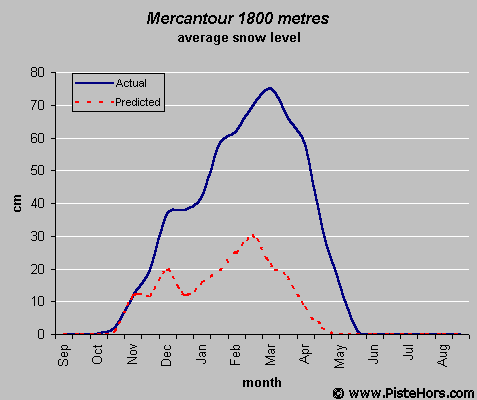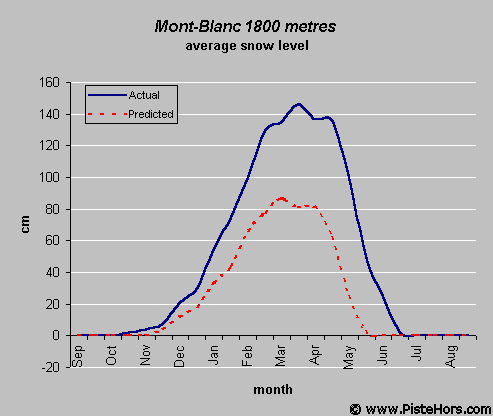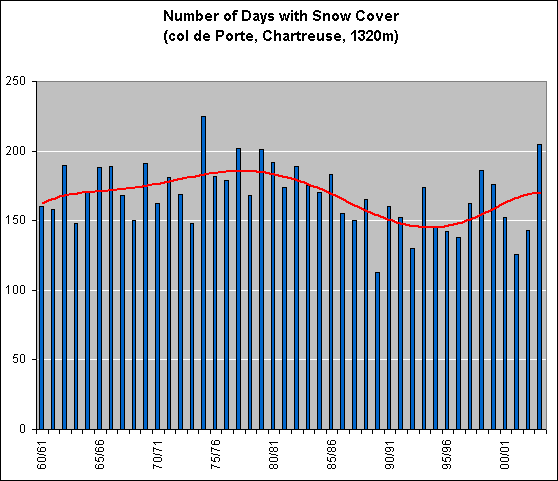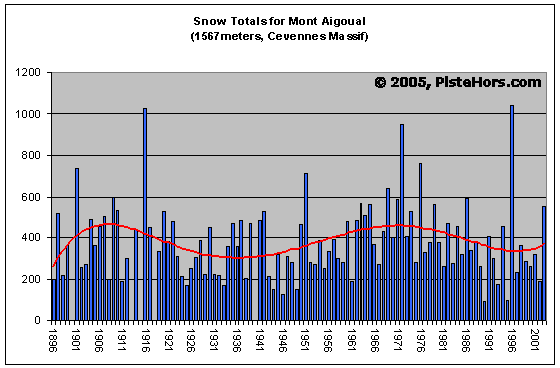
Weather > The Effects of Global Warming on Skiing > The Future Of French Skiing
Skiers will also have to take advantage of the prevailing weather conditions and go skiing in November (as in 1996) or later in the season. This poses an additional problem for the big resorts, as most of their staff are on fixed contracts and often work elsewhere outside of those dates. Cross country skiers and especially ski mountaineers are more flexible in both area and calendar, they may discover the joys of spring snow in the middle of January and may invest in modern and lightweight ski equipment destined for competition use to make approach walks more bearable. They will also seek out new routes. The change in conditions will boost the new fashion for snow-shoes, which in 2003 overtook cross-country skiing with 15% of the winter sports activity and with over 100,000 pairs now being sold in a season.
Given all of the above two questions remain to be answered. Why, over the last ten years has less snow fallen in the Northern Alps at low and mid-altitudes and will this trend continue? Two questions which it is very difficult to answer at this time with any assurance. It is possible to begin with some observations, it is evident that the west and north-westerly humid air streams that bring snow to the Alps have either been blocked by stable anti-cyclones or have tended towards the south. There is also the probability of global warming, 0.5C over the last century and an acceleration since 1980. Global warming since industrialisation and reduced precipitation is the probable cause for the 50% shrinking in the amount of glaciated terrain in Europe over that period.
Apart from that, things are much less certain. It has not been demonstrated that the global warming, with predictions varying between a 1.5 to 6C rise in temperature over the next hundred years is directly connected to the level of CO2 in the atmosphere. Even if this is certain it may simply be amplifying or even counter-balancing other climatic effects such as the mini-ice age that occurred between 1550-1860. Global warming may also have widely differing effects at different locations, something that simulations have trouble predicting.
However it would seem that snowfall in the Alps will be affected by global climate change. Recent work at the Centre for Snow Studies at Météo France has already given food for thought. The CROCUS model used a constant level of precipitation but doubled the amount of CO2 in the atmosphere, the effects on snowfall were dramatic (see graphics).

Meteo France Snowfall Predictions for the Mercantour, Alpes Maritimes
February, for example, will see about 30 to 50 cm less snow at 1500 meters compared with the average for the last 30 years. The winter will also be 40 days shorter. Snow levels were affected right up to 2,500 meters. This means that future snow-levels on the Col du Lautaret near Serre Chevalier (around 2000 meters) will come to resemble those of the Col de la Croix Haute (around 1000 meters).
Other simulations take into account the influence of the oceans and the effect on precipitation - more heat means more evaporation and more precipitation. This gives different results especially between one mountain range and another. At 1500 meters the snow-levels are still less but the effect is more marked in the Northern Alps. At higher altitudes there may even be more snow, especially in the Oisans and Mont Blanc.

Meteo France Snowfall Predictions for Mont Blanc
It is not just the ski industry that is affected by snow conditions. Farmers rely on the spring melt water to irrigated their crops. The drought during the winter of 2001-2002 left reservoirs empty and parched fields in Provence. Electricity companies also rely on melting snow to run turbines to generate electricity. The French electric company, the EDF, employs mountain guides throughout the winter to make snowfall measurements in order to predict the reserves.
The EDF also funded a study by Frédéric Hendrickx, member of the Research and Development team, that appeared in November 2000. This study asked what would happen if temperatures rise 2 to 3 degrees by 2050, caused by a doubling of the carbon-dioxide found in the atmosphere. A hypothesis slightly towards the higher end of predictions for Northern Europe (predictions range from 1C to 3.5C). Hendrickx's findings are more extreme than those of Météo France. The first snowfalls in 2050 would be around mid-November compared to the October today, with between 30-45% less snow at 1500 meters, a snow pack reduced by 2/3rds and a winter around 60 days shorter.

(Red line shows 5th order polynomial trend line)
At 2,500 meters the picture is a little better, 15-20% less snow and a winter 25-35 days shorter. If we take the observations made at the Col de Porte from 1960 to 2004 and extrapolate them to 2050, then, assuming a linear trend, winter will be some 25 days shorter, somewhat less extreme than Hendrickx's predictions. However recent winters have been somewhat better than those during the 1980. This shows that the climate is variable and that it is difficult to extract meaningful trends from such short timescales.

(Red line shows 5th order polynomial trend line)
The weather observatory at the Mont Aigoual to the south of Cérvennes mountains has accurate snowfall records stretching back over a century. The Aigoual Massif is the first mountain obstacle for the warm, damp winds coming up from the Mediterranean. The high altitude makes it into a powerful rain (and snow) making machine. Its 1567 meter summit is one of the wettest places in France. It sees huge variations in climate with over a 50C temperature span from the coldest days in winter to the warmest days of summer. The winter of 1995-1996 was the snowiest since records began in 1894, with a total of 10.39 meters of fresh snow. The trends seem similar to the Col de Porte with an increase in snowfall coinciding with the boom construction years in the French ski industry and, despite 95-96, a drought in the late 80s and 90s. Once again we appear to be entering a period with more snowfall at least during the main winter months.
Daniel Duband from Météo France thinks the temperature rise used in the EDF report is too large, "in the little ice age, at 1600 meters altitude, we saw a temperature drop of around 0.5 to 1 degree in the east of Europe, I'm not saying the study is wrong, it just doesn't correspond with our experience. On the other hand people have a whole load of images in their heads: there are no more seasons, the world is in meltdown, we're entering a new era in terms of climate etc. Making this study public, even with a caution, reinforces these ideas whereas climate change has always been the norm". It is certainly true that between 1000-1200 meters predicting snowfall from one year to the next is a lottery, however the trend over the last four decades is less snow on average . Louis Raynaud, a researcher at the Glacial and Geophysical Laboratory in Grenoble explains "The Glaciers prove it, since the little ice age there hasbeen an average 0.6 degree rise in temperatures, that's just an average, behind it there are wide fluctuations which are completely normal, 50 years ago, when there were no ski resorts, no-one paid much attention. During 1977 and 1983 we had some very exceptional years, some people invested in areas whereas they should have taken time to consult the historical record, they thought the good times would last, nowadays people ask us before they start new developments."
When faced with this veritable avalanche of predictions, more or less disastrous, one should remain cautious. Don't throw your skis in the trash, after all some experts have also predicted a modification in the Gulf Stream as the Artic ice melts. This could make the French Alps even colder and might make skiing on the English Downs a possibility! The 2004 disaster movie: The Day After even postulated runaway global cooling where monster storms suck supercooled air down from the troposphere returning much of northern Europe and North America to the ice age!
If should also be remembered that a 'correct' amount of snow-fall may depend on only two or three big dumps in a season - the dates being strategic. Too early in November and the first big dump will fall as rain giving a poor start to the season with problems later on.
For the next ten to twenty years it is likely we will remain with the situation we have experienced over the last decade. Poor snow at low altitude but with several real winters. Skiers in the 21st century will have to search for snow depending on altitude and area, country and even continent. They will have to remain mobile and available and have a fat bank account, that is until the change in the Gulf Stream...
Parts of this article are based on a paper published in the December 1998 Skieur Magazine, a special edition of Alpinisme and Randonnee, by Jacques Villecrose and titled: Will their be snow tomorrow?. Jacques Villecrose, who died in 2004, was a Meteorologist for Metéo-France, Grenoble.
Snowfall figures for Villard de Lans and les Arcs from Christian Gibert. French Ski Resort Average Snow Depths
Chiffres clés du tourisme en montagne - édition 2002
Chiffres clés du tourisme en montagne - édition 2004
The Variable Sun, Spencer Weart & American Institute of Physics
Rapid Climate Change, Spencer Weart & American Institute of Physics
Climate Shock, Abrupt Changes Over Millennial Time Scales, Edoaurd Bard, College de France (PDF Format)
Climate Change Science, US National Research Council
Influences of climate change over the 20th Century on four French glacier mass balances, C Vincent, Laboratoire de Glaciologie, CNRS, Grenoble
Les Grands Hivers et la Ligne du Cactus, Gilles Modica; Montagnes Magazine No. 290; February 2005
Glaciers et Climats, Robert Vivian, 2001
Rever Huez et les Grandes Rousses, Roger Canac, 2006, Glénat
Additional research by David George
Copyright © David George 1998 - 2006
<< Climate Change and Skiing | The Effects of Global Warming on Skiing | Europe's Shrinking Glaciers >>